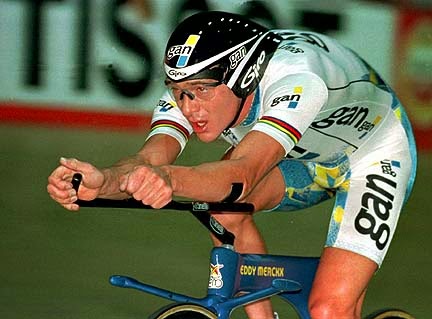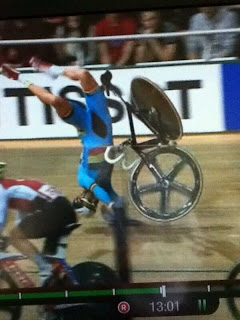Who Can Save the Hour?
Yesterday, in the final chapter of a storied career that has been defined
by daring raids, Jens Voigt claimed what may just be his greatest coup: the
Hour Record.
He certainly had some outside help, as the UCI’s bizarre
muddying of their own waters meant that to join the Hour’s Hall of Heroes he
had to beat not one of cycling’s greats but rather a shady Czech who hadn’t had
aero bars.
While Voigt’s record is certainly a worthy capstone to his
career, you do get the impression that even Voigt knows he has snuck his way
onto the record book. Fitting, as so many of his great victories were accomplished
in hail-mary moves that few believed would succeed.
But the Hour Record used to be something more, something
better. For most of the men who have
held the hour have been the sports greats. Titans who rode the hour to confirm
their place amongst cycling’s Pantheon. Coppi held the Hour. Anquetil held the Hour. Merckx defined what it meant to ride the
Hour. Public demand pretty much forced Indurain to ride it in the 90’s- his
legacy was not complete without it. It
is no accident that of the five time tour winners, three have held the Hour (if
I ever meet Hinault I will ask him why he has not)
How I imagine the response
If the Hour Record seems close to my heart it is because the
period when I was first getting into cycling in the mid-nineties saw the Hour
under assault on an epic scale. At an
age when sporting heroes and deeds have greater shine and luster Boardman
captivated me in particular, but equally astounding was the wild-card nature of
Obree who dared to assault Cycling’s Mount Olympus not once but twice.
Such was the furor raised by these two Brits (perhaps
forbearers of what was to come for British Cycling) that two of the biggest
names in the sport at the time were eventually lured in to restore order: five
time tour winner Miguel Indurain and Tony Rominger. Rominger was perhaps the best modern rider to
never win the tour and he in particular assaulted the hour with meticulous
detail. Such was Rominger’s confidence
that he became the first rider since Moser to attack his own record:
establishing the bar dizzyling high at 55.29 km in 1994.
At the time most of us believed that the fireworks were
over, that surely Rominger had put the record out of reach for years to come
and that order had been restored to the Hour.
But less than two years later, Chris Boardman, at probably
the height of his physical powers smashed that record, riding the improbably
distance of 56.37 km. In doing so he
averaged 4:15 pursuit pace for 60 minutes.
Each of those 4km splits would have been good enough to qualify for the
World Championships gold medal pursuit final that year- more than 14 times in a
row.
This was clearly the biggest concern of the UCI in '96
To say the UCI panicked would probably be accurate. They banned the superman position, and they
banned Boardman’s Lotus designed frame.
But they made a false assumption- that the machine made the man. In doing so they felt they needed to move the
goalposts so that the record would ever again be attainable.
So they pulled their woolen berets over their eyes,
pretended it had all never happened and reset the clock to the great Eddy Mercx
(ironically whose attempt at altitude had been the culmination of the science
of the day).
And in doing so they ruined the Hour. It lost its prestige, its very defining
characteristic as the leading edge of the sports progression of man and
machine.
Sweet fixie man
The Hour had always been a magical mix of applied science
and preparation and sheer simple brutality.
As Obree put it “There is you, a black line, a watch, and nothing
else. Succeed and you are a legend, fail
and it will haunt you for years.”
Riders like Moser had pushed the ragged edge of the sports
boundaries (in more ways that one as him and Dr. Conconi saw it as the ultimate
application of science, medicine and technology). No longer was this the case, and the lack of
interest in the record for 15 years has shown.
The great Chris Boardman was wheeled out to again set the
record, and valiantly pushed the mark a teensy smidge past Mercx’s old
mark. But this wasn’t just Boardman
without the bike, this was a Boardman in the shadow of his own career- neither
man nor machine were what they had been in 1996.
Hopefully Voigt’s ride will inspire a new generation to
again try and push the sporting limits of the hour- and in doing so push man’s
own limit. But it is hard for me to be
inspired by Voigt’s ride when he failed to even beat the 30 year old mark of
Moser- set outdoors, on a concrete track and without aero bars.
Conconi aside this can't have been a faster set up
But at least under the new rules the door is open. 56.37km is there for the taking for he who
would dare. Boardman’s pursuit record of
4:11, set on the same bike and the same track as his Hour eventually fell. And so two will his Hour. Man and machine will continue to march
forwards despite the best efforts of the UCI.
I just hope a rider emerges to push the new “unified” record
past the historical marks and return to Hour to its former glory from the sham
it has become.
Caveat: there is a women’s Hour as well, currently held by
Van Moorsel that is also now ripe for the taking under the Unified Rules.
Caveat 2: it’s been pointed out there is also an unlimited
funny bike Hour Record- but I would contend that not being set by the
sports stars (unless their is a huge underground recumbent racing scene I am ignorant of) makes it void of the Hours romance and prestige.
























